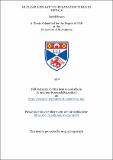Nuclear spin-lattice relaxation times in metals
Abstract
This thesis is a report of an experimental and theoretical investigation of dipolar spin-lattice relaxation times in pure metals. Both the usual Zeeman as well as the dipolar relaxation times were measured as a function of temperature in Al⁸⁰ Cu, V, Cd⁸⁰ and Pt. The metals Al, Cu and V all have nuclear spin > ½; so they show strong quadrupole effects which complicate the analysis. Non-exponential spin-lattice decays are observed in these metals. A model explaining this and leading to the elucidation of the true dipolar relaxation time is presented. These complications are not present for Cd and Pt since they both have nuclear spin ½; and hence no quadrupole moment. In these metals however the dipolar relaxation is strongly influenced by the presence of indirect nuclear-nuclear couplings. These measurements require the use of a phase-coherent pulse spectrometer capable of measuring spin-lattice relaxation times over a wide temperature range. A suitable apparatus and the experimental techniques are described. The parameter discussed in the relevant theories of dipolar relaxation is δ, the ratio of Zeeman to dipolar relaxation times. The following values were found.
Al δ = 2.15 ± .07; Cu δ= 2.08 ± .15; V δ = 2.15 ± .20; Pt δ = 1.28 ± .07; Cd δ = 1.43 ± .15 The overlap with previous investigations concerned the metals A1 and Cu. The results reported here are in considerably better agreement with theory. The general characteristic of the results is the need to invoke electron-electron interactions in an explanation of the values of 5. The measurements in Pt and V are difficult to interpret because their dominant relaxation mechanisms are not discussed in existing theories. A theory of nuclear relaxation which considers the effects of a δ-function Interaction between electrons partially explains the remaining results but a residual discrepancy exists in all cases, This may be due to the restrictive assumptions of the theory which make It relevant only to simple metals" Of the metals investigated here Cu approaches the requirements most closely. However application of the theory to a simple metal such as Na still leaves a discrepancy between predicted and measured values of B. The effects of introducing a finite range to the electron-electron interaction are discussed. It appears that failure to fully explain the results is due in part to the inherent inadequacies of existing theories and in part to the complicated electronic structures of the metals Investigated which make the formulation of a more general theory very difficult.
Type
Thesis, PhD Doctor of Philosophy
Collections
Items in the St Andrews Research Repository are protected by copyright, with all rights reserved, unless otherwise indicated.

